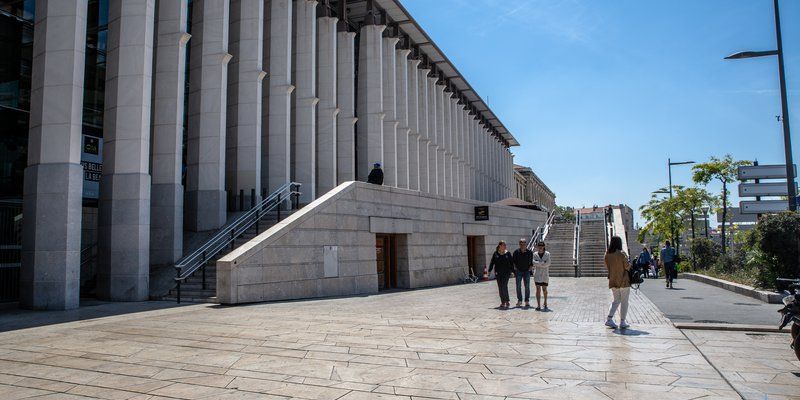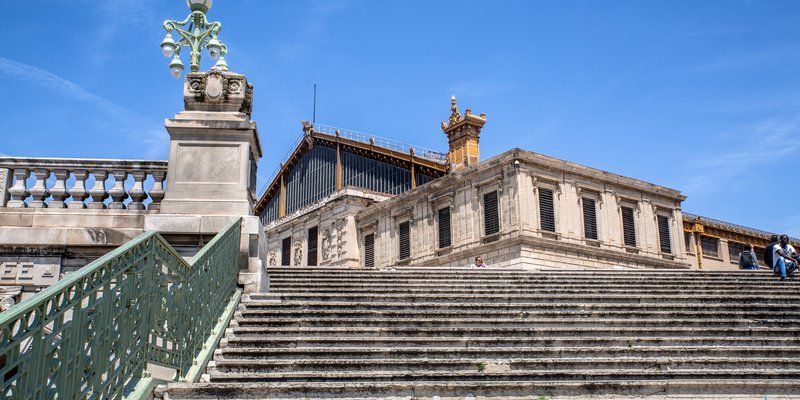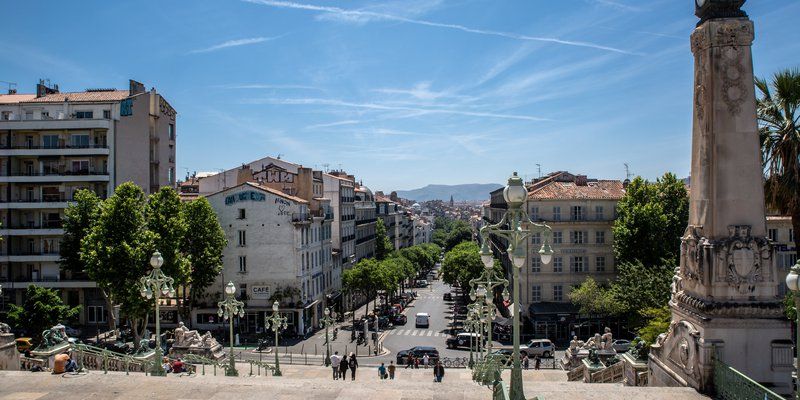Marseille's central station: 104 steps of history
More than just a station, Gare Saint Charles is a historical monument. Renovated recently, it takes you on a journey through the history of Marseille.
This was born from the urgent need to connect Marseille to the rail network in the midst of the industrial revolution when the city was experiencing a real economic boom.
Construction of the Gare Saint Charles
It all began in 1847 with the opening of the Nerthe tunnel, which links the city to the railway network. The architect Gustave Desplaces, which is also behind the Docks de la Joliette, is in charge of the construction of the Gare Saint Charles. It was commissioned and inaugurated on January 8, 1848 by Bishop de Mazenod, Archbishop of Marseille, but it was not completely completed until a few years later. The first line in service was the Paris - Lyon - Marseille line.
But once completed, a problem remained. The Saint Charles station remained cut off from the city centre by the buildings of the Petit Séminaire and the Belsunce school which occupied the top of the Boulevard d'Athènes. To overcome this problem, the State bought these buildings in 1903. The need for a staircase linking the station to Boulevard d'Athènes began to be felt. A competition was organized by the municipality, and in August 1911 the project was launched. At the top of the Boulevard of Athens was the statue of the "Golden Virgin", erected in 1857 in honour of the Immaculate Conception. The statue is moved not far from there, on the Boulevard de la liberté where it still stands today.
The stairs of the Gare Saint Charles
The architect Eugène Sénès, assisted by Léon Arnel, was awarded the project. The ornamentation and realization of the sculptures were entrusted to Louis-François Carli and Auguste Carli, Ary Bitter, Henri Reybaud...
After some delays due in particular to the First World War, the work was carried out until 1921. The books evoke the colonies of Asia and Africa, the products of Provence: the grape harvests, the fruits, the flowers, the harvest and the peach and are present at each level.
The stairs were inaugurated on April 24, 1927. It was the President of the Republic himself, Gaston Doumergue, flanked by the Mayor of Marseille, Dr. Siméon Flaissières, who inaugurated the new 16-metre high staircase, composed of 104 steps, cut by 7 landings. On the same day, the monument to the heroes of the Eastern army was also inaugurated.
Saint Charles nowadays
The station in its current version was built from 1893 to 1896 by the architect Joseph Antoine Bouvard. The buildings are constructed in a U-shaped shape around a large glass roof.
The site has undergone various renovations to expand it to accommodate an ever-increasing number of passengers who have come to work or spend their holidays in Marseille. In colonial times, Marseille was the starting point for settlements in distant lands and travellers used to travel through the station. Thus, the district has been transformed for these visitors who often stayed only one evening or one day. That's why there are so many hotels on the Boulevard d'Athènes. There were two successive periods of expansion in 1970 and 1980. Then a last restructuring undertaken in 2001 and completed in 2007.
Saint Charles: a key centre for public transport
Saint Charles Station is connected to the city by its extensive public transport network (trains, buses, subways and trams). It is therefore very accessible to both Marseilles residents and tourists who come to visit Marseille. The Phocaean city is now 3 hours from Paris thanks to the TGV! You no longer have any excuses not to come and visit the tourist sites and monuments of Marseille!
And if you're wondering what to visit in Marseille, it seems you're on the right site 😀 We've put together a list of must-see attractions in Marseille. Once you have your train ticket in your pocket, all you have to do is choose which emblematic places in Marseille you want to see! Moreover, if you want to visit our beautiful city while enjoying the sunny weather, why not opt for bike rental, or segway rental? Finally, remember to buy your entrance tickets at the ticket office in order to avoid waiting in line.
The stairs of the station: a real architectural museum
When you climb the stairs of the Gare Saint Charles from the bottom, you will successively meet the following sculptures:
Louis Botinelly's Asian and African columns:
Marseille is an important port for trade and commerce with these distant lands. The two colonies are represented by two face-to-face statues representing elongated women each accompanied by a child.
Each representation naturally refers to the regions mentioned and their specificities.
Henri Raybaud's bronze sculptures:
Six small bronze statues are on the railings. They represent the great classics of Provence, its wealth and its products. Thus, we find representations of fruits, fishing, flowers, harvesting and hunting.
The sculpted pillars topped with a lantern by Auguste Carli and Henri Martin:
On this large intermediate landing, we find two large pillars topped by a lantern. Each has a sculpture representing a female allegory resting on the bow of a ship adorned with a ram's head. On the left,
the representation of the Gate of the East is sitting on a seat from which two griffins emerge. On the right, the Greek allegory holds a statue of the goddess Diana in her hand. On each side of the pylons,
there are city coats of arms: Nice, Paris, Aix, Marseille and Lyon.
The lion and the child of Ary Bitter:
These are the last works before reaching the top of the stairs and thus arriving at the station. On either side of the stairs, the two statues each represent a lion with a child.
On one side is the inscription, "the sun and the sea" and on the other side is "the world and energy".



